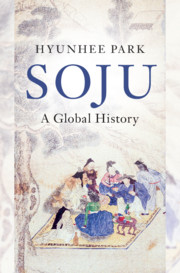Book contents
- Soju
- ASIAN CONNECTIONS
- Soju
- Copyright page
- Dedication
- Contents
- Maps
- Illustrations
- Acknowledgments
- Note on Transliteration and Other Conventions
- Introduction
- 1 Soju and Arak
- 2 The Mongols and the Rise of Soju in Koryŏ Korea
- 3 Contextualizing Soju
- 4 Distilling Soju at Court and Home in Chosŏn Korea
- 5 Challenges of Modernity
- 6 Alcohol Globalism
- Conclusion
- Works Cited
- Index
- Asian Connections
3 - Contextualizing Soju
Political Relations and Cultural Transfers between the Mongol Empire and Koryŏ Korea
Published online by Cambridge University Press: 21 January 2021
- Soju
- ASIAN CONNECTIONS
- Soju
- Copyright page
- Dedication
- Contents
- Maps
- Illustrations
- Acknowledgments
- Note on Transliteration and Other Conventions
- Introduction
- 1 Soju and Arak
- 2 The Mongols and the Rise of Soju in Koryŏ Korea
- 3 Contextualizing Soju
- 4 Distilling Soju at Court and Home in Chosŏn Korea
- 5 Challenges of Modernity
- 6 Alcohol Globalism
- Conclusion
- Works Cited
- Index
- Asian Connections
Summary
Chapter 3 examines cross-cultural contacts between the Koryŏ dynasty (918–1392) in Korea and the Yuan dynasty (1271–1368) in China and Mongolia (and the broader Mongol Empire), in order to refine our historical context to make clear the kind of Sino-Korean interactions that made the transfer of distilled liquors to Korea possible. As its suzerain state on Koryŏ’s border for nearly 150 years, the Mongols were able to exert considerable influence on Korea. This opened the way to a wide range of cross-cultural interactions, from the stationing of Mongol soldiers on Cheju Island to trade to court relations and intermarriage, situations that created opportunities for the exchange of such things as liquors, concepts of drinking culture, and still technologies, laying the foundations for soju’s development. Such a process is not excusive to alcohol; we see similar patterns in a variety of cultural artifacts (even Korean foods and national dress). Cross-cultural interactions between the Yuan and Koryŏ realms provided Koreans with access to genuinely cosmopolitan societies in Eurasia, so the range of influences went well beyond China or the Mongols. In this way, soju provides an excellent vehicle for understanding both the extent of Eurasian influence on Korea and also Korea’s place in Eurasia under the Pax Mongolica.
Keywords
- Type
- Chapter
- Information
- SojuA Global History, pp. 96 - 126Publisher: Cambridge University PressPrint publication year: 2021

